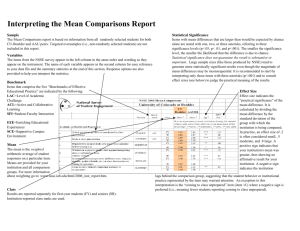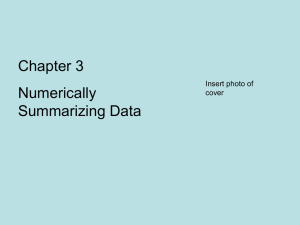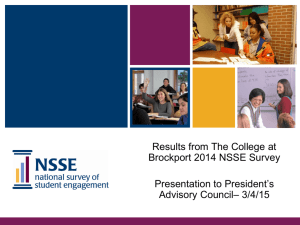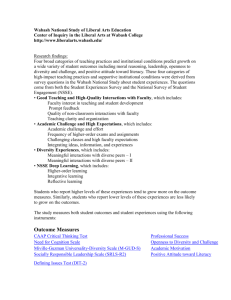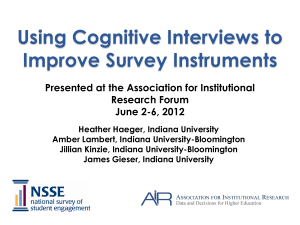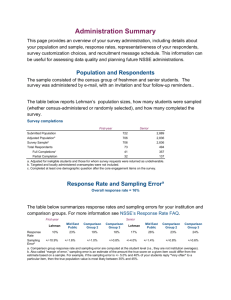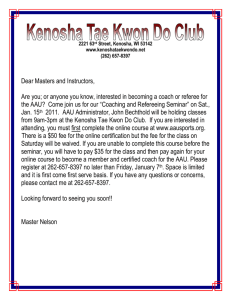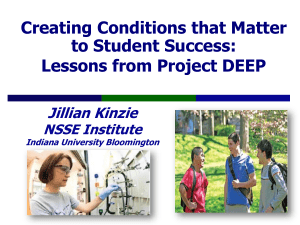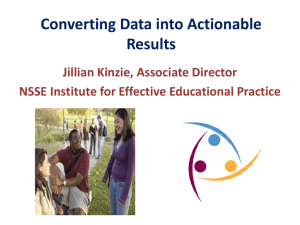NSSE 2013: What You Need to Know Holly Oakleaf Sheila Craft
advertisement
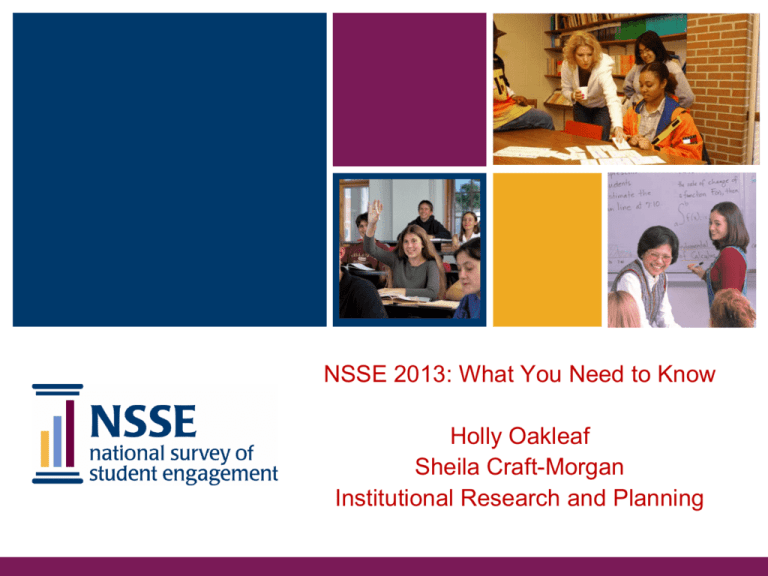
NSSE 2013: What You Need to Know Holly Oakleaf Sheila Craft-Morgan Institutional Research and Planning Presentation Overview 1. NSSE and the Concept of Student Engagement 2. Administration at Ohio State 3. Selected NSSE Results 4. Next Steps NSSE and the Concept of Student Engagement What is Student Engagement? • What students do - time and energy devoted to studies and other educationally purposeful activities • What institutions do - using resources and effective educational practices to induce students to do the right things Seven Principles of Good Practice in Undergraduate Education Student-faculty contact Active learning Prompt feedback Time on task High expectations Experiences with diversity Cooperation among students Chickering, A. W. & Gamson, Z. F. (1987). Seven principles for good practice in undergraduate education. AAHE: Bulletin, 39 (7), 3-7. Other Supporting Literature After reviewing approximately 2,500 studies on college students from the 1990s, in addition to the more than 2,600 studies from 1970 to 1990, Ernest Pascarella and Patrick Terenzini concluded student engagement is a central component of student learning. Pascarella, E. & Terenzini, P (2005). How college affects students: A third decade of research. San Francisco: Jossey-Bass Publishers. Presents institutional policies, programs, and practices that promote student success. Provides practical guidance on implementation of effective institutional practice in a variety of contexts. Kuh, G. D., Kinzie, J., Schuh, J. H., Whitt, E.J., & Associates (2005). Student success in college: Creating conditions that matter. San Francisco: Jossey-Bass. NSSE Updated in 2013! New Items: HIPs, quantitative reasoning, effective teaching, deep approaches, topical modules NSSE Engagement Indicators Meaningful Academic Engagement Themes Engagement Indicators Academic Challenge Learning with Peers Experiences with Faculty Campus Environment Student – Faculty Interaction Administration at Ohio State Spring 2013 Administration Population: Census of first-year students at all campuses Topical Modules Advising Learning with Technology (Regional campuses only) AAU Consortium Questions (Columbus campus on.ly NSSE 2013 Respondent Demographics • Response Rates ranged from 9% to 12% for all campuses • National response rate for first year students: 27% • Respondents were fairly representative of the population Respondent Characteristics Population Respondents 90% 92% 78% 84% 60% 71% 69% 48% Female Full-time FTFY White Respondent Rates Social Media Incentives Selected NSSE Results Overall Satisfaction Overall Satisfaction If you could start over again, would you go to the same institution you are now attending? 88% How would you evaluate your entire educational experience at this institution? 88% 88% 88% 0% AAU Institutions 20% 40% Ohio State 60% 80% 100% How do students spend their time? 100% 80% 73% 69% 60% 35% 40% 38% 20% 0% Preparing for Class (>10 hrs/wk) Ohio State Participating in co-curricular activities (>5 hrs/wk) AAU Institutions How do students spend their time? Time Spent Working for Pay 100% 80% 77% 75% 81% 79% 60% 40% 20% 0% On campus (0 hours/wk) Ohio State Off campus (0 hours/wk) AAU Institutions High‐Impact Practices Columbus Campus – All Students 62% *Participated in at least one HIP 48% 16% 13% Participated in two or more HIPs 6% 5% Research with Faculty 52% *Service Learning 35% 24% 23% Learning Community 0% 20% AAU Institutions *Statistically Significant 40% Ohio State 60% 80% 100% High‐Impact Practices Columbus Campus – Retained Students 49% 49% Participated in at least one HIP 11% 14% Participated in two or more HIPs 9% 5% Research with Faculty 42% 34% Service Learning 10% *Learning Community 26% 0% 20% Not Retained *Statistically Significant 40% Retained 60% 80% 100% Engagement Indicators Overall results compared to AAU Institutions for each Engagement Indicator. Theme Academic Challenge Learning with Peers Experiences with Faculty Campus Environment Engagement Indicator First-year Higher-Order Learning (HO) -- Reflective & Integrative Learning (RI) ▽ Learning Strategies (LS) -- Quantitative Reasoning (QR) -- Collaborative Learning (CL) Discussions with Diverse Others (DD) ▽ △ Student-Faculty Interaction (SF) -- Effective Teaching Practices (ET) -- Quality of Interactions (QI) -- Supportive Environment (SE) ▲ Higher Order Learning During the current school year, how much has your coursework emphasized the following? FORMING a new idea or understanding from various pieces of information 55% EVALUATING a point of view, decision, or information source 56% 64% 63% *ANALYZING an idea, experience, or line of reasoning in depth by examining its parts 58% 72% APPLYING facts, theories, or methods to practical problems or new situations 72% 79% 0% Not Retained *Statistically Significant 20% Retained 40% 60% 80% 100% Learning Strategies During the current school year, about how often have you done the following? 54% Summarized what you learned in class or from course materials 58% 59% *Reviewed your notes after class 70% 73% *Identified key information from reading assignments 84% 0% Male *Statistically Significant 20% Female 40% 60% 80% 100% Quantitative Reasoning During the current school year, about how often have you done the following? 29% *Evaluated what others have concluded from numerical information 40% Used numerical information to examine a realworld problem or issue (unemployment, climate change, public health, etc.) 35% 40% *Reached conclusions based on your own analysis of numerical information (numbers, graphs, statistics, etc.) 45% 58% 0% Not Retained *Statistically Significant 20% Retained 40% 60% 80% 100% Collaborative Learning During the current school year, about how often have you done the following? Worked with other students on course projects or assignments 38% *Prepared for exams by discussing or working through course material with other students 49% 27% *Explained course material to one or more students 64% 39% *Asked another student to help you understand course material 34% 0% FTFY *Statistically Significant 47% 20% Not FTFY 40% 55% 60% 80% 100% Discussions with Diverse Others During the current school year, about how often have you done the following? *Had discussions with people with political views other than your own 62% *Had discussions with people with religious beliefs other than your own 76% 67% *Had discussions with people from an economic background other than your own 61% *Had discussions with people of a race or ethnicity other than your own 78% 73% 67% 0% FTFY *Statistically Significant 78% 20% Not FTFY 40% 60% 80% 100% Student-Faculty Interaction Student - Faculty Interaction 26% Discussed your academic performance with a faculty member 20% 25% Discussed course topiocs, ideas, or concepts with a faculty member outside of class 21% AAUDE OSU 15% Worked with faculty on activities other an coursework (committees, student groups, etc.) 16% 31% Talked about career plans with a faculty member 29% 0% 5% 10% 15% 20% 25% 30% 35% Effective Teaching Practices Effective Teaching Practices Used examples or illustrations to explain difficult points Taught course session in an organized way 79.5% 20.5% 82.3% 17.7% 52.4% 47.6% Provided prompt and detailed feedback on tests or completed assignments Not Substantial 50.7% 49.3% Provided feedback on a draft or wok in progress Clearly explained course goals and requirements Substantial 82.5% 17.5% 0.0% 10.0% 20.0% 30.0% 40.0% 50.0% 60.0% 70.0% 80.0% 90.0% Quality of Interactions 79% of FY students said that OSU substantially emphasized the use of learning support service 50% of FY students gave the quality of their interactions with academic advisors as high 64% of FY students gave the quality of their interactions with their peers a high rating Supportive Environment Supportive Environment Using learning support services (tutoring services, writing center, etc.) 80% 20% Spending significant amounts of time studying and on academic work 87% 13% Providing support to help students succeed academically 79% 21% Providing support for your overall well-being (recreation, health care, counseling, etc.) 84% 16% Providing opportunities to be involved socially 83% 17% Not Substantial Helping you manage your non-academic responsibilities (work, family, etc.) 48% 52% Encouraging contact among students form different backgrounds (social, racial/ethnic, religious , etc.) 36% Attending events that address important social, economic, or political issues 39% Attending campus activities and events (performing arts, athletic events, etc.) 20% 0% Substantial 64% 61% 80% 10% 20% 30% 40% 50% 60% 70% 80% 90% 100% Academic Advising Academic Advising 33% Provided useful information about courses 63% 24% Listened closely to your concerns and questions 70% 28% Informed you of important deadlines 68% 36% Informed you of academic support options 33% Helped you when you had academic difficulties 58% Infrequently 42% Frequently 29% Helped you understand academic rules and policies 66% 38% Helped you get information on special opportunities 46% 44% 44% Discussed your career interests and post-graduation goals 24% Been available when needed 0% 10% 20% 30% 71% 40% 50% 60% 70% 80% Academic Advising During the current school year, which of the following has been your primary source of advice regarding your academic plans? (Select one) Website, catalog, other published sources Other, please specify Online Advising system (degree progress repot, etc.) I did not seek academic advice this year 5.3% 2.3% 3.1% 5.3% Friends or other students 11.8% Family members 19.1% Faculty or staff not formally assigned as an advisor 6.7% Academic Advisor(s) available to any student 7.8% Academic Advisor(s) assigned to you 0.0% 38.6% 5.0% 10.0% 15.0% 20.0% 25.0% 30.0% 35.0% 40.0% 45.0% Academic Advising How many times have you and an academic advisor discussed your academic interests, course selections, or academic performance? 0 6.4% 1 20.1% 2 27.6% 3 25.0% 4 5 9.5% 5.1% 6 or more 0.0% 6.4% 5.0% 10.0% 15.0% 20.0% 25.0% 30.0% Learning with Technology Teaching with new, cutting‐edge technologies Quite a bit/Very Much Mansfield Newark Marion Very little/some 0.0% 10.0% 20.0% 30.0% 40.0% 50.0% 60.0% 70.0% Learning with Technology Providing technology to help you learn, study or complete coursework Quite a bit/Very Much Mansfield Newark Marion Very little/some 0.0% 10.0% 20.0% 30.0% 40.0% 50.0% 60.0% 70.0% 80.0% Learning with Technology Providing support services to assist you with your use of technology Quite a bit/Very Much Mansfield Newark Marion Very little/some 0.0% 10.0% 20.0% 30.0% 40.0% 50.0% 60.0% 70.0% Discussion and Next Steps Contact Information The Ohio State University NSSE Contact: Sheila Craft-Morgan or Holly Oakleaf craft-morgan.1@osu.edu oakleaf.4@osu.edu . Center for Postsecondary Research Indiana University School of Education 1900 East Tenth Street, Suite 419 Bloomington, IN 47406-7512 Phone: 812-856-5824 Fax: 812-856-5150 Email: nsse@indiana.edu Web: nsse.iub.edu
